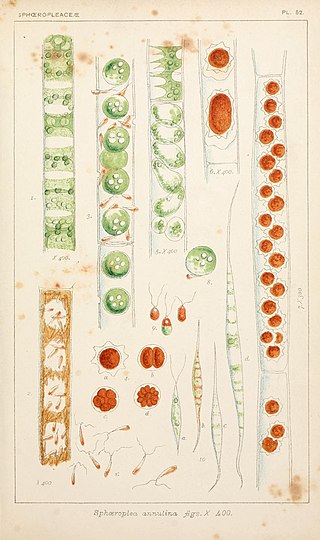
The water net is a taxon of freshwater green algae in the family Hydrodictyaceae. Hydrodictyon does well in clean, eutrophic water, and has become a nuisance in New Zealand, where it has been recently introduced. The name water net comes from the mesh structure of their colonies, which can extend several decimeters; the scientific name also means "water net" in Greek.

Hydrodictyaceae is a family of green algae in the order Sphaeropleales. They are found in freshwater habitats worldwide.

Chlorococcaceae is a family of green algae, in the order Chlamydomonadales. They are mostly soil-dwelling algae. Many members of this group produce lipids and secondary carotenoids.

Asterococcus is a genus of green algae in the order Chlamydomonadales. It is planktonic in freshwater ponds and lakes, or benthic within mires and swamps. It is a common and widespread genus, but is rarely abundant.
Characiochloris is a genus of green algae in the family Characiochloridaceae. Characiochloris is epiphytic on freshwater algae, or found in soil.
Characiosiphon is a genus of green algae in the family Characiosiphonaceae. It contains a single species, Characiosiphon rivularis.

Characium is a genus of green algae in the family Characiaceae. It is very commonly found in freshwater habitats, where it is attached to phytoplankton or zooplankton.

Chlamydocapsa is a genus of green algae, specifically of the Chlorophyceae.

Lobomonas is a genus of green algae in the family Chlamydomonadaceae, found in freshwater habitats. Although it is widely distributed, it is a rare genus.

Neochloris is a genus of green algae in the family Neochloridaceae. It is found in freshwater aquatic and terrestrial soil habitats.
Palmellopsis is a genus of green algae, specifically of the Palmellopsidaceae. They are either planktonic or attached to substrates in fresh water, or in aeroterrestrial habitats.

Planktosphaeria is a genus of Chlorophyceae of the green algae. It was first described by the phycologist Gilbert Morgan Smith in 1918, with Planktosphaeria gelatinosa as its type species. Species of Planktosphaeria are commonly found in freshwater plankton around the world.

Sorastrum is a genus of green algae in the family Hydrodictyaceae. It is a component of the phytoplankton of freshwater ponds, lakes, and ditches. Sorastrum is common in tropical to temperate regions of the world, but due to its small size it is often overlooked.

Sphaeroplea is a genus of green algae in the family Sphaeropleaceae. It was first circumscribed by the Swedish botanist Carl Adolph Agardh in 1824.

Trebouxia is a unicellular green alga. It is a photosynthetic organism that can exist in almost all habitats found in polar, tropical, and temperate regions. It can either exist in a symbiotic relationship with fungi in the form of lichen or it can survive independently as a free-living organism alone or in colonies. Trebouxia is the most common photobiont in extant lichens. It is a primary producer of marine, freshwater and terrestrial ecosystems. It uses carotenoids and chlorophyll a and b to harvest energy from the sun and provide nutrients to various animals and insects.
Vitreochlamys is a genus of green algae in the family Chlamydomonadaceae. It is sometimes known by the name Sphaerellopsis, published by Aleksandr Arkadievich Korshikov. However, that name is an illegitimate later homonym, preceded by SphaerellopsisM.C.Cooke. It is commonly found in freshwater habitats.
Deuterocharacium is a genus of green algae in the family Characiaceae. It is found in freshwater habitats, attached to algae or detritus. It is rare and has only been recorded from Europe.
Korshikoviella is a genus of green algae in the family Characiaceae.
Cecidochloris is a green algae genus in the family Chlorangiellaceae. It occurs in freshwater. However, it has only been reported so far from Europe, with an additional species from India that is incompletely described.

Apiocystis is a genus of algae belonging to the family Tetrasporaceae. It is found attached to freshwater aquatic algae or plants. The species of this genus are found in Europe and Northern America, and are widespread but generally uncommon.













